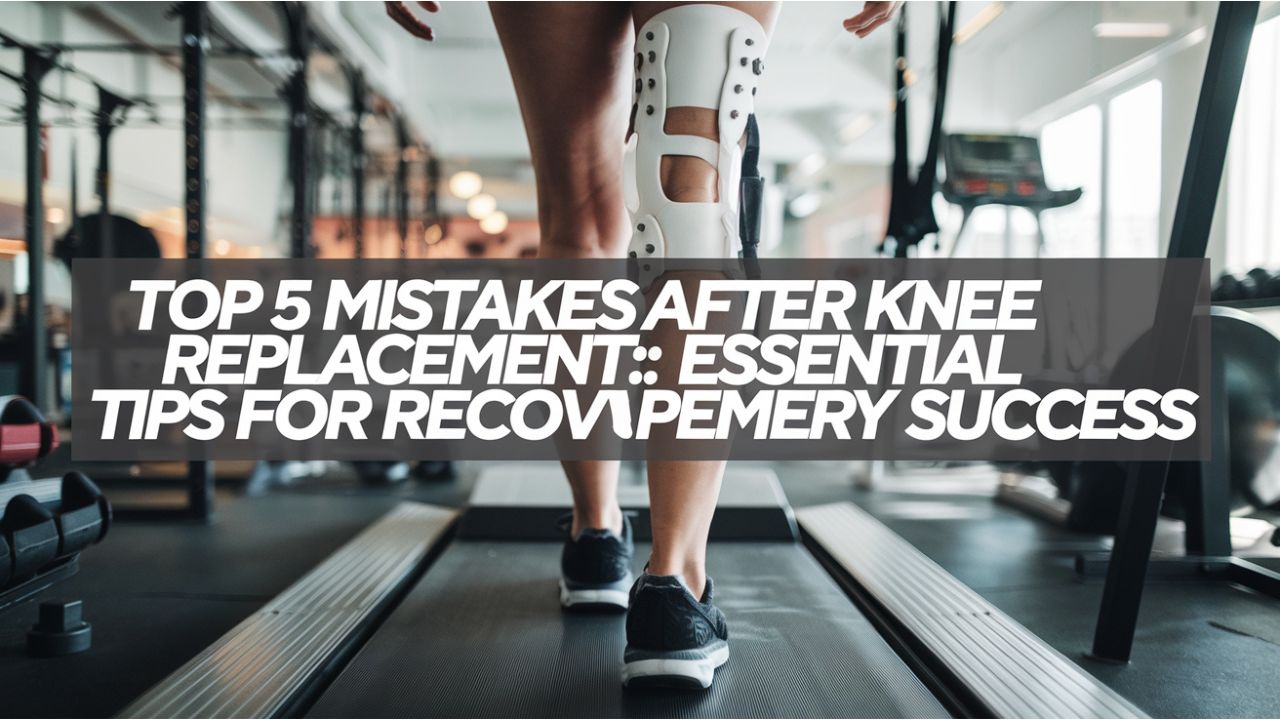Top 5 Mistakes After Knee Replacement surgery has become an increasingly common procedure for individuals experiencing debilitating knee pain and limited mobility due to arthritis or injury. This surgical intervention can bring tremendous relief, but the recovery process is crucial for achieving the best possible outcomes. Unfortunately, there are common pitfalls that many patients encounter during recovery, which can impede their healing and lead to setbacks. In this article, we explore the top five mistakes people make after knee replacement surgery and how to avoid them for a smooth, successful recovery journey.
Understanding Knee Replacement Surgery
Knee replacement surgery involves replacing damaged knee joint components with artificial implants to restore functionality and alleviate chronic pain. The process often entails removing damaged bone and cartilage and placing metal and plastic implants to create a new joint surface. Though highly successful, this procedure requires careful post-operative care to ensure the knee heals correctly and the patient regains strength, flexibility, and stability.
Why Avoiding Mistakes Post-Surgery Is Crucial
After knee replacement, patients must follow specific guidelines for physical activity, diet, and medication to promote healing. Even small missteps in the recovery process can lead to increased pain, swelling, and even long-term complications. Understanding and avoiding common mistakes is vital for those undergoing knee replacement to reduce recovery time and improve overall quality of life.
Top 5 Mistakes After Knee Replacement Surgery
Not Following Physical Therapy Routines
Physical therapy is a cornerstone of successful recovery after knee replacement. Unfortunately, some patients underestimate its importance, skip sessions, or fail to follow the exercises recommended by their therapist. This can significantly impact recovery, as physical therapy helps restore strength, range of motion, and stability in the knee. Without consistent therapy, patients may experience stiffness, muscle weakness, and reduced joint function.
How to Avoid This Mistake:
- Commit to Physical Therapy: Make every effort to attend sessions as scheduled and follow your therapist’s guidance on at-home exercises.
- Set Realistic Goals: Work with your therapist to establish achievable milestones for recovery.
- Communicate Pain Levels: Be honest with your therapist about pain or discomfort, as they can modify exercises to suit your needs.
Overdoing Physical Activities Too Soon
While movement is essential for healing, overdoing it can be equally detrimental. Many patients feel encouraged by their improved mobility after surgery and may push themselves to return to activities too quickly. Engaging in strenuous physical activities can strain the new knee joint, leading to swelling, pain, or even implant complications.
How to Avoid This Mistake:
- Follow a Gradual Activity Plan: Stick to a plan that gradually increases activity levels over time.
- Listen to Your Body: Pay attention to pain and swelling as indicators that you may be overexerting yourself.
- Avoid High-Impact Activities Early On: Refrain from running, jumping, or heavy lifting until cleared by your doctor.
Ignoring Pain or Swelling
It’s natural to experience some discomfort after knee replacement surgery, but persistent pain or swelling can indicate an issue with the joint or the healing process. Ignoring these symptoms or failing to consult a doctor can delay recovery or lead to further complications.
How to Avoid This Mistake:
- Monitor Your Symptoms Closely: Track any unusual pain, swelling, or stiffness in your knee.
- Stay in Touch with Your Healthcare Provider: Consult your doctor if symptoms worsen, as they may need to adjust your treatment plan.
- Practice Rest and Ice Therapy: Elevate and ice your knee to reduce swelling and alleviate pain as recommended by your care team.
Skipping Medications or Mismanaging Pain Relief
Many patients fear becoming dependent on pain medications, while others might forget to take them as prescribed. Not managing pain appropriately can cause unnecessary suffering and slow down the healing process. Pain management is essential for mobility, enabling you to perform exercises and follow your recovery plan effectively.
How to Avoid This Mistake:
- Stick to Your Medication Schedule: Take medications as prescribed to control pain and inflammation.
- Explore Alternative Pain Relief Options: Ask your doctor about safe alternatives like ice packs, over-the-counter medications, or physical therapy.
- Gradually Taper Off: When it’s time, consult your doctor on gradually reducing medication rather than abruptly stopping.
Not Preparing the Home for Recovery
A significant yet often overlooked aspect of knee replacement recovery is ensuring a safe and supportive home environment. Patients may not anticipate the challenges of moving around post-surgery, which can result in falls or unnecessary strain on the new knee joint.
How to Avoid This Mistake:
- Arrange Essential Items at Waist Level: Place commonly used items within easy reach to avoid unnecessary bending or stretching.
- Use Assistive Devices: Consider grab bars, a walker, or a raised toilet seat to minimize strain.
- Clear Pathways: Ensure walkways are free of clutter, and install nonslip mats in potentially slippery areas.
Additional Tips for a Smooth Knee Replacement Recovery
To further support recovery, patients can adopt additional practices that promote healing and well-being.
Maintain a Balanced Diet
Proper nutrition is vital for tissue repair and overall energy levels during recovery. Focus on a balanced diet rich in proteins, vitamins, and minerals to support healing. Staying hydrated and consuming anti-inflammatory foods can also aid in reducing post-surgery inflammation.
Practice Patience and Positivity
Recovery can be challenging, both physically and mentally. Staying positive, setting small goals, and celebrating progress can enhance motivation and improve outcomes. Engage in relaxing activities and allow yourself time to heal without rushing the process.
FAQs
What should I avoid after knee replacement surgery?
- Avoid high-impact activities, excessive bending, and any actions that put undue strain on the new knee joint.
How long does it take to recover from knee replacement surgery?
- While recovery times vary, many patients see improvement within three to six months. Full recovery may take up to a year.
Can I resume sports after knee replacement surgery?
- Low-impact sports like swimming or cycling are generally acceptable, but always consult your doctor before resuming any sports activities.
What is the role of physical therapy in knee replacement recovery?
- Physical therapy is crucial for regaining strength, flexibility, and range of motion. It helps prevent complications and enhances overall recovery outcomes.
How can I manage pain during knee replacement recovery?
- Use prescribed medications, ice therapy, and gentle exercises to manage pain. Follow your doctor’s advice on pain management.
When can I return to work after knee replacement?
- Many patients can return to light-duty work within four to six weeks, though it depends on the job’s physical demands and the individual’s recovery progress.
Conclusion
Top 5 Mistakes After Knee Replacement surgery offers the possibility of a pain-free, active life, but recovery requires dedication, patience, and adherence to medical guidance. Avoiding these top five mistakes can make all the difference in achieving a successful outcome. By embracing a proactive approach, including consistent physical therapy, gradual reintroduction to activities, pain management, and a supportive home environment, you can maximize the benefits of your knee replacement and move confidently toward a brighter, more mobile future.











